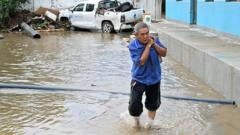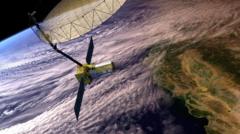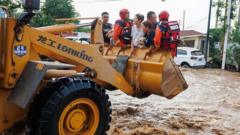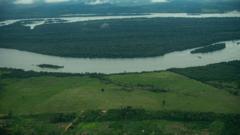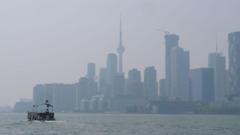Experts project a doubling or tripling of severe turbulence incidents as atmospheric conditions shift, raising safety and economic concerns for airlines and passengers alike.
**Rising Turbulence: How Climate Change is Transforming Air Travel**
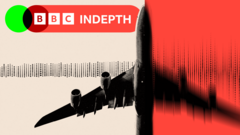
**Rising Turbulence: How Climate Change is Transforming Air Travel**
The phenomenon of severe turbulence in air travel is increasing in frequency and intensity due to changing climate patterns.
In recent decades, travelers have often experienced unprecedented turbulence during flights, leading many to scrutinize its causes and implications. One such case is Andrew Davies, who encountered severe turbulence while en route to New Zealand. His initial leg from London to Singapore was uneventful until the aircraft plunged dramatically, causing chaos in the cabin. While Davies emerged with minor injuries, he noted that others were not so fortunate, noting a tragic heart attack among the passengers.
Fatalities from turbulence remain incredibly rare, with only a handful of recorded cases since the early 1980s. In the U.S., the National Transportation Safety Board reported 207 severe injury incidents since 2009, underscoring a significant problem even in the absence of fatalities. Turbulence was responsible for nearly 40% of serious injuries this year, accentuating its mounting impact on aviation.
A concerning trend is emerging from climate scientists. As atmospheric conditions fluctuate due to climate change, the severity of turbulence is expected to rise. Paul Williams, an atmospheric scientist at the University of Reading, warns of a potential increase in severe turbulence experiences, predicting that flights which currently encounter 10 minutes of severe turbulence might soon experience 20 to 30 minutes, an alarming change for frequent flyers.
Severe turbulence, defined by g-forces exceeding 1.5, can lead to drastic drops of significant heights within seconds. In recent years, routes over the North Atlantic have witnessed a 55% surge in turbulence incidents. It's believed that climate change is directly linked to heightened turbulence, with warmer air noted to foster stronger storm systems and consequently more intense convective turbulence.
Convective turbulence, typically resulting from storm dynamics, is exacerbated by climate change's effect on atmospheric moisture and heat retention. As more intense thunderstorms develop, the potential for turbulence rises sharply, leading to chaotic flying experiences.
Airlines have been proactive in circumventing turbulence to ensure passenger safety. While obscured turbulence is notoriously challenging to detect, advancements in forecasting techniques have improved clarity about where turbulence might occur. Better predictive tools allow airlines to adjust flight paths. However, the economic ramifications of turbulence are significant, with costs surpassing millions due to flight change necessities, fuel waste, and the need for aircraft maintenance after severe turbulence incidents.
Experts believe that solutions to mitigate turbulence risks are within reach. Innovations include turbulence-canceling technology for smaller aircraft and design improvements inspired by nature. Observing how barn owls navigate turbulent winds showcases possible advancements for future aircraft designs to help stabilize flights during bumpy conditions.
Despite the fears surrounding turbulence and the potential for increased severity in future flights, professionals assert that flying remains safe. Pilots emphasize the resilience of aircraft structures to turbulence forces, traditionally viewed as an inconvenience rather than a threat. Nevertheless, routine advice for passengers remains firm: keep seatbelts fastened at all times during flights, especially as colder air and changing climatic temperatures exert greater influences within our skies.
Fatalities from turbulence remain incredibly rare, with only a handful of recorded cases since the early 1980s. In the U.S., the National Transportation Safety Board reported 207 severe injury incidents since 2009, underscoring a significant problem even in the absence of fatalities. Turbulence was responsible for nearly 40% of serious injuries this year, accentuating its mounting impact on aviation.
A concerning trend is emerging from climate scientists. As atmospheric conditions fluctuate due to climate change, the severity of turbulence is expected to rise. Paul Williams, an atmospheric scientist at the University of Reading, warns of a potential increase in severe turbulence experiences, predicting that flights which currently encounter 10 minutes of severe turbulence might soon experience 20 to 30 minutes, an alarming change for frequent flyers.
Severe turbulence, defined by g-forces exceeding 1.5, can lead to drastic drops of significant heights within seconds. In recent years, routes over the North Atlantic have witnessed a 55% surge in turbulence incidents. It's believed that climate change is directly linked to heightened turbulence, with warmer air noted to foster stronger storm systems and consequently more intense convective turbulence.
Convective turbulence, typically resulting from storm dynamics, is exacerbated by climate change's effect on atmospheric moisture and heat retention. As more intense thunderstorms develop, the potential for turbulence rises sharply, leading to chaotic flying experiences.
Airlines have been proactive in circumventing turbulence to ensure passenger safety. While obscured turbulence is notoriously challenging to detect, advancements in forecasting techniques have improved clarity about where turbulence might occur. Better predictive tools allow airlines to adjust flight paths. However, the economic ramifications of turbulence are significant, with costs surpassing millions due to flight change necessities, fuel waste, and the need for aircraft maintenance after severe turbulence incidents.
Experts believe that solutions to mitigate turbulence risks are within reach. Innovations include turbulence-canceling technology for smaller aircraft and design improvements inspired by nature. Observing how barn owls navigate turbulent winds showcases possible advancements for future aircraft designs to help stabilize flights during bumpy conditions.
Despite the fears surrounding turbulence and the potential for increased severity in future flights, professionals assert that flying remains safe. Pilots emphasize the resilience of aircraft structures to turbulence forces, traditionally viewed as an inconvenience rather than a threat. Nevertheless, routine advice for passengers remains firm: keep seatbelts fastened at all times during flights, especially as colder air and changing climatic temperatures exert greater influences within our skies.

